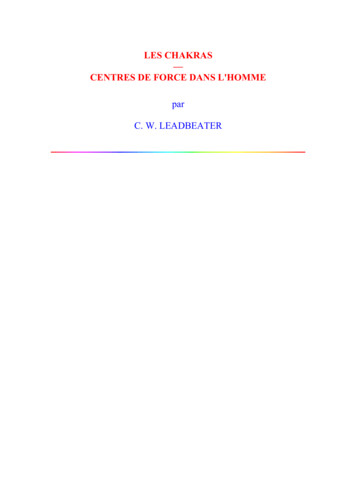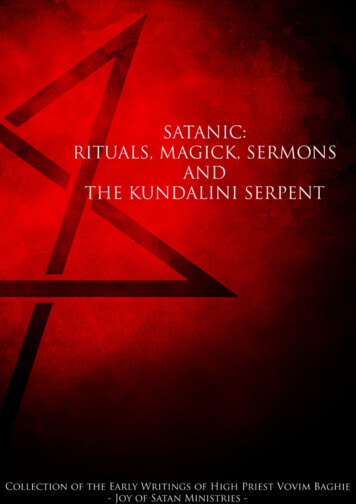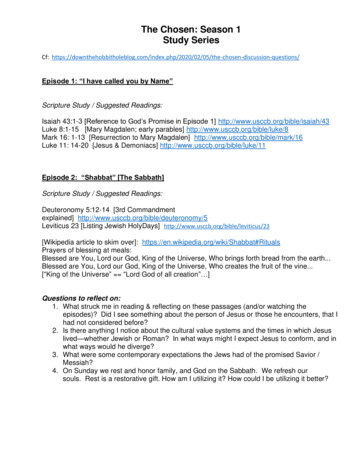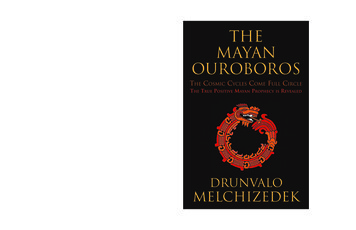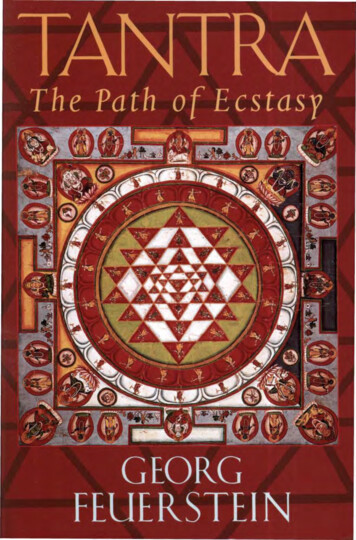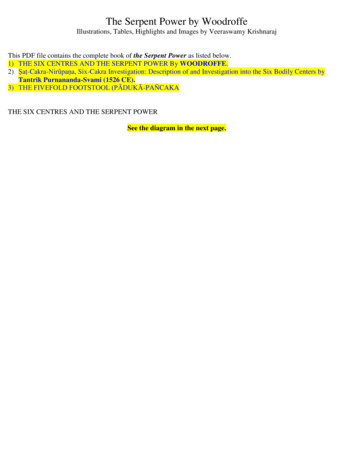
Transcription
The Serpent Power by WoodroffeIllustrations, Tables, Highlights and Images by Veeraswamy KrishnarajThis PDF file contains the complete book of the Serpent Power as listed below.1) THE SIX CENTRES AND THE SERPENT POWER By WOODROFFE.2) Ṣaṭ-Cakra-Nirūpaṇa, Six-Cakra Investigation: Description of and Investigation into the Six Bodily Centers byTantrik Purnananda-Svami (1526 CE).3) THE FIVEFOLD FOOTSTOOL (PĀDUKĀ-PAÑCAKATHE SIX CENTRES AND THE SERPENT POWERSee the diagram in the next page.
INTRODUCTION PAGE 1THE two Sanskrit works here translated---Ṣat-cakra-nirūpaṇa (" Description of the Six Centres, or Cakras") andPādukāpañcaka (" Fivefold footstool ")-deal with a particular form of Tantrik Yoga named Kuṇḍalinī -Yoga or, as someworks call it, Bhūta-śuddhi, These names refer to the Kuṇḍalinī-Śakti, or Supreme Power in the human body by thearousing of which the Yoga is achieved, and to the purification of the Elements of the body (Bhūta-śuddhi) which takes
place upon that event. This Yoga is effected by a process technically known as Ṣat-cakra-bheda, or piercing of the SixCentres or Regions (Cakra) or Lotuses (Padma) of the body (which the work describes) by the agency of KuṇḍalinīSakti, which, in order to give it an English name, I have here called the Serpent Power.1 Kuṇḍala means coiled. Thepower is the Goddess (Devī) Kuṇḍalinī, or that which is coiled; for Her form is that of a coiled and sleeping serpent inthe lowest bodily centre, at the base of the spinal column, until by the means described She is aroused in that Yogawhich is named after Her. Kuṇḍalinī is the Divine Cosmic Energy in bodieslOne of the names of this Devī is Bhujaṅgī, or the Serpent.2 THE SIX CENTRES AND THE SERPENT POWER(v. post). The Saptabhūmi, or seven regions (Lokas).1 are, as popularly understood, an exoteric presentment of the innerTāntrik teaching regarding the seven centres. 2The Yoga is called Tāntrik for a twofold reason. It will be found mentioned in the Yoga-Upaniṣads which refer to theCentres, or Cakras, and in some of the Purāṇas. The treatises on Haṭhayoga also deal with the subject. We find evensimilar notions in systems other than the Indian, from which possibly in some cases they have been borrowed. Thus, inthe Risala-i-haq-numa, by Prince Mahomed Dara Shikoh,3 a description is given of the three centres" Mother of Brain,"or "Spherical heart" (Dil-i-muddawar); the" Cedar heart" (Dil-i-sanowbari); and the Dil-i-nilofari, or "Lily heart.4."Other references may be found in the works of the Mahomedan Sufis. So some of the Sufi fraternities (as theNaqshbandi) are said 5 to have devised, or rather borrowed, from the Indian Yogis 6 the Kuṇḍalinī method as a means torealization.7 I am told that correspondences are discoverable1 The seven" worlds" Bhiūh, Bhuvah, Suvah, Mahah, Janah, Tapah, Satya. See my "Wave of Bliss" (Comm. to v. 35). Lokas are what are seen (lokyante)-thatis, attained-and are hence the fruits of Karma in the form of particular re-birth. Satyānanda's" Comm. on ĪŚa Up.," Mantra 2. See p. 258.2 That is, the six Cakras and the upper cerebral centre, or Sahasrāra. As to Upaniṣads and Purāṇas, see post.3 "The Compass of Truth." The author was the eldest son of the Emperor Shah-i-Jehan, and died in A.D. 1659. Its teaching is alleged to be that of the secretdoctrine of the" Apostle of God."4 Chapter I on Alam-i-nasut: the physical plane, or what the Hindus call the Jagrat state. Ed. Rai Bahadur Srisha-Candra-Vasu.5 See "The Development of Metaphysics in Persia," by Shaikh Muhammed Iqbal, p. 110.6 Al-Biruni is said to have translated Patañjali's works, as also the Sāmkhya-Sūtras, into Arabic at the beginning of the eleventh century.7 The author cited, however, says: "Such methods of contemplation are quite unislamic in character, and the higher Sufis do not attach any importance to them."INTRODUCTION 3between the Indian (Asiatic) Sastra and the American-Indian Māyā Scripture of the Zunis called the Popul Vuh.1 Myinformant tells me that their" air-tube" is the Susumna; their" twofold air-tube" the Nāḍīs Idā and Piṅgala. "Hurakan," orlightning, is Kuṇḍalinī, and the centres are depicted by animal glyphs. Similar notions have been reported to me as beingheld in the secret teaching of other communities. That the doctrine and practice should be widespread, we might expect,if it has a foundation on fact. This form of Yoga is, however, in particular associated with the Tantras or Agamas, firstly,because these Scriptures are largely concerned therewith. In fact, such orderly descriptions in practical full detail as havebeen written are to be found chiefly in the Haṭhayoga works and Tantras which are the manuals, not only of Hinduworship, but of its occultism. Next, Yoga through action on the lowest centre seems characteristic of the Tāntrik system,the adepts of which are the custodians of the practical knowledge whereby the general directions in the books may bepractically applied. The system is of a Tāntrik character also in respect of its selection of the chief centre ofconsciousness. Various people have in antiquity assigned to various parts of the body the seat of the" soul" or life, suchas the blood2 the heart and the breath. Generally the brain was not so regarded. The Vaidik system posits the heart as thechief centre of Consciousness--a relic of which notion we also still preserve in such as "take it to heart" and to "learn byheart". Sādhaka, which is one of the five functions of Pitta,3 and which is situated in the heart.1 A translation was, I am told, begun and not finished by the occultist James Pryse in Lucifer, the old Theosophical journal, which I have not seen.2 Cj. the Biblical saying, "The blood is the life".3 See p. 12 of the Introduction to the third volume of my Tāntrik Texts (Prapañcasāra- Tantra).4 THE SIX CENTRES AND THE SERPENT POWER
indirectly assists in the performance of cognitive functions by keeping up the rhythmic cardiac contractions, and it hasbeen suggested 1 that it was perhaps this view of the heart's construction which predisposed Indian physiologists to holdit to be the seat of cognition. According to the Tantras, however, the chief centres of consciousness are to be found inthe Cakras of the cerebro-spinal system and in the upper brain (Sahasrāra), which they describe, though the heart is alsorecognized as a seat of the Jivātmā, or embodied spirit, in its aspect as vital principle or Praṇa2. It is for the reasonsmentioned that the first verse of the Saṭ-cakra-nirūpaṇa here translated speaks of the Yoga which is to be achieved"according to the Tantras" (Tantrānusāreṃa--that is, as Kālīcaraṇa, its Commentator, says, "following the authority ofthe Tantras".Recently some attention has been given to the subject in Western literature of an occult kind. Generally its authors andothers have purported to give what they understood to be the Hindu theory of the matter, but with considerableinaccuracies. These are not limited to works of the character mentioned. Thus, to take but two instances of theserespective classes, we find in a well-known Sanskrit dictionary 3 that the Cakras are defined to be" circles or depressions(sic) of the body for mystical or chiromantic purposes," and their location has in almost every particular been wronglygiven. The1 Kavidirāja-Kuñjalāla-Bhiṣagaratna in his edition of the SuśrutaSaṁhitā, Another explanation, however, may be given-namely, that during man's history theimportance of the various perceptive centres has in fact varied.2 According to some Indian views, the brain is the centre of the mind and senses, and the heart that of life. Caraka says that the heart is the root from whichspring all other parts of the body, and is the centre of some of the functions or organs. According to Suśruta, the heart is the seat of sensations.3 Professor Monier Williams' Sanskrit Dictionary, sub voce" Cakra ".INTRODUCTION 5Mūlādhāra is inaccurately described as being "above the pubis". Nor is the Svādhiṣṭhāna the umbilical region. Anāhatais not the root of the nose, but is the spinal centre in the region of the heart; Viśuddha is not "the hollow between thefrontal sinuses," but is the spinal centre in the region of the throat. Ājñā is not the fontanelle or union of the coronal andsagittal sutures, which are said to be the Brahma-randhra,1 but is in the position allotted to the third eye, or Jñāna-cakṣu.Others, avoiding such gross errors, are not free from lesser inaccuracies. Thus, an author who, I am informed, hadconsiderable knowledge of things occult, speaks of the Suṣumnā as a " force" which "cannot be energised until Īdā andPiṅgalā have preceded it," which "passes to the accompaniment of violent shock through each section of the spinalmarrow," and which, on the awakening of the sacral plexus, passes along the spinal cord and impinges on the brain, withthe result that the neophyte finds" himself to be an unembodied soul alone in the black abyss of empty space, strugglingagainst dread and terror unutterable". He also writes that the "current" of Kuṇḍalinī is called Nāḍī; that Suṣumnā extendsas a nerve to the Brahma-randhra; that the Tattvas are seven in number; and other matters which are inaccurate. TheSusumna is not a "force," 2 and does not pass and impinge upon anything, but is the outer of the three Nadis, which formthe conduit for the force which is the arousing of the Devī called Kuṇḍalinī, the Cosmic Power in bodies, which force isnot itself a Nāḍī, but passes through the innermost, of Citriṇī- Nāḍī, which terminates at the twelve-petalled lotus belowthe Sahasrāra, from which ascent is made to the Brahma-randhra. It would be easy to. 1 A term which is also employed to denote the Brahma- Nāḍī, in that the latter is the passage whereby the Brahma-randhra in the cerebrum is attained.2 Except in the sense that everything is a manifestation of power.PAGE 6 THE SIX CENTRES AND THE SERPENT POWERIt would be easy to point out other mistakes in writers who have referred to the subject. It will be more profitable if Imake as correct a statement as my knowledge admits of this mode of Yoga.But I desire to add that some modern Indian writers have also helped to diffuse erroneous notions about the Cakrasby describing them from what is merely a materialistic or physiological standpoint. To do so is not merely tomisrepresent the case, but to give it away; for physiology does not know the Cakras as they exist in themselves - that is,as centres of consciousness - and of the activity of Sūkṣma Prāṇa-Vāyu or subtle vital force; though it does deal with thegross body which is related to them. Those who appeal to physiology only are likely to return non-suited.We may here notice the account of a well-known "Theosophical" author1 regarding what he calls the "Forcecentres" and the "Serpent Fire," of which he writes that he has had personal experience. Though its author also
refers to the Yoga Śāstra, it may perhaps exclude error if we here point out that his account does not profess tobe a representation of the teaching of the Indian Yogis (whose competence for their own Yoga the author somewhatdisparages), but that it is put forward as the Author's own original explanation (fortified, as he conceives, by certainportions of Indian teaching) of the personal experience which (he writes) he himself has had. This experience appearsto consist in the conscious arousing of the "Serpent Fire,"2 with the enhanced "astral" and mental vision which hebelieves has shown him what he tells us.1 "The Inner Life," by C. W. Leadbeater, pp.443-478, First Series.2This and the following notes compare his and the Indian theory.The Devī or Goddess is called Bhujangi or Serpent because at the lowest centre (Mūlādhāra ) She lies "coiled" round theLiṅga. "Coiled" at rest. The Cosmic Power in bodies is here at rest; when roused it is felt as intense heat.INTRODUCTION PAGE 7believes has shown him what he tells us.1 The centres, or Cakras, of the human body are described to be vortices of"etheric" matter2 into which rush from the "astral"3 world, and at right angles to the plane of the whirling disc, thesevenfold force of the Logos bringing " divine life " into the physical body. Though all these seven forces operate on allthe centres, in each of them one form of the force is greatly predominant. These inrushing forces are alleged to set up onthe surface of the "etheric double"4 secondary forces at right angles to themselves. The primary force on entrance intothe vortex radiates again in straight lines, but at right angles. The number of these radiations of the primal force is saidto determine the number of "petals"5 (as the Hindus call them) which the "Lotus" or vortex exhibits. The secondaryforce rushing round the vortex produces, it is said, the appearance of the petals of a flower, or, "perhaps moreaccurately, saucers or Śallow vases of wavy iridescent glass". In this way - that is, by the supposition of an ethericvortex subject to an incoming force ofthe Logos - both the "Lotuses" described in the Hindu books and the number of their petals is accounted for bythe author, who substitutes for the Svādhiṣṭhāna centre a six-petalled lotus at the spleen,4 and corrects the numberof petals of the lotus in the head, which he says is not a thousand, as the books of this Yoga say, "but exactly 960" 6The "etheric" centre which keeps alive the physical vehicle is said to correspond with an "astral" centre of fourdimensions, but between them is a closely woven sheath or web composed of a single compressed layer of physicalatoms, which prevents a premature opening up of communication between the planes.1 Certain Siddhis or occult powers are acquired at each centre as the practitioner works his way upwards.2 The petals of the lotus are Prāṇa-Śakti manifested by PrāṇaVāyu or vital force. Each lotus is a centre of a different form of matter" (Bhūta) there predominant. - A.A.3 This is a Western term. - A.A.4 Not mentioned in the account here given. - A.A.5 See last note but three.6So little attention seems to be given to exactitude in this matter that one of the letters is dropped in order to make1,000 petals - that is,50X20. "Thousand" is,here, only symbolic of magnitude. - A.A.PAGE 8 THE SIX CENTRES AND THE SERPENT POWERis said to correspond with an "astral" centre of four dimensions, but between them is a closely woven sheath or webcomposed of a single compressed layer of physical atoms, which prevents a premature opening up of communicationbetween the planes.There is a way, it is said, in which these may be properly opened or developed so as to bring more through this channelfrom the higher planes than ordinarily passes thereby. Each of these "astral" centres has certain functions: at the navel, asimple power of feeling; at the spleen, "conscious travel" in the astral body; at the heart, "a power to comprehend andsympathise with the vibrations of other astral entities"; at the throat, power of hearing on the astral plane; between theeyebrows, "astral sight"; at the "top of the head," perfection of all faculties of the astral life.1 These centres are thereforesaid to take the place to some extent of sense organs for the astral body. In the first centre, "at the base of the spine," isthe "Serpent Fire," or Kuṇḍalinī, which exists in seven layers or seven degrees of force.2 This is the manifestation inetheric matter, on the physical plane, of one of the great world forces, one of the powers of the Logos of which vitalityand electricity are examples. It is not, it is said, the same as Prāṇa, or vitality.3The "etheric centres" when fully aroused by the "Serpent Fire" bring down, it is alleged, into physical consciousnesswhatever may be the quality inherent in the astral centre which corresponds to it. When vivified by the "SerpentFire" they become gates of connection between the physical and "astral" bodies.1 Certain Siddhis are said to be gained at each centre. But the top of the head is far beyond the "astral" life. There Samādhi, or union with the SupremeConsciousness, is had. - A.A.2 Para-śabda which is Kuṇḍalinī in Her aspect as cause of all sound has seven aspects from Kuṇḍalī to Bindu.- A.A.3 Kuṇḍalī is Śabda-Brahman or the "Word (Vāk)" in bodies, and is in Her own form (Svarūpa) Pure Consciousness, and is all Powers
(SarvaŚakti mayi). Kuṇḍalinī is in fact the cosmic energy in bodies and as such the cause of all and though manifesting as, is not confinedto, any of Her products. - A.A.PAGE 9 INTRODUCTIONthe physical and "astral" bodies. When the astral awakening of these centres first took place, this was not known to thephysical consciousness. But the sense body can now "be brought to Shareall these advantages by repeating that processof awakening with the etheric centres". This is done by the arousing through will-force of the "Serpent Fire," whichexists clothed in "etheric matter in the physical plane, and sleeps1 in the corresponding etheric centre - that at thebase of the spine". When this is done, it vivifies the higher centres, with the effect that it brings into the physicalconsciousness the powers which were aroused by the development of their corresponding astral centres. In short, onebegins to live on the astral plane, which is not altogether 'an advantage, were it not that entry into the heaven world issaid to be achieved at the close of life on this plane.2Svadhisthana Cakra : Thus, at the second centre, one is conscious in the physical body "of all kinds of astral influences,vaguely feeling that some of them are friendly and some hostile without in the least knowing why".Maṇipūra Cakra : At the third centre one is enabled to remember "only partially" vague astral journeys, with sometimeshalf-remembrance of a blissful sensation of flying through the air.Anāhata Cakra : At the fourth centre man is instinctively aware of the joys and sorrows of others, sometimesreproducing in himself their physical aches and pains.Viśuddha Cakra : At the arousing of the fifth centre he hears voices "which make all kinds of suggestions to him".Sometimes he hears music "or other less pleasant sounds".3 Full development secures clairaudience in the "astral"plane.1Kuṇḍalinī is called the Serpent (Bhujangi). She sleeps in the Mūlādhāra. As to what She is, see last note. She sleeps because She is at rest. Then man'sconsciousness is awake to the world, Her creation, in which She is immanent. When She awakes and Yoga is completed man sleeps to the world and enjoyssuper-worldly experience.2The end of Kuṇḍalī Yoga is beyond all Heaven worlds. No Yogi seeks "Heaven" but union with that which is the source of all worlds.3 According to the text translated, the sound of the Śabda-Brahman is heard at the Anāhata, or fourth centre. - A.A.10 THE SIX CENTRES AND THE SERPENT POWERĀjñā Cakra : The arousing of the sixth centre secures results which are at first of a trivial character, such as "half seeinglandscapes and clouds of colour," but subsequently amount to clairvoyance. Here it is said there is a power ofmagnification by means of an "etheric" flexible tube which resembles "the microscopic snake on the head-dress of thePharaohs". The Power to expand or control the eye of this "microscopic snake" is stated to be the meaning of thestatement, in ancient books, of the capacity to make oneself large or small at will.1 When the pituitary body is broughtinto working order, it forms a link with the astral vehicle, and when the Fire reaches the sixth centre, and fully vivifiesit, the voice of the "Master" (which in this case means the higher self in its various stages) is heard.2Sahasrāra Cakra : The awakening of the seventh centre enables one to leave the body in full consciousness."When the fire has thus passed through all these centres in a certain order (which varies for different types of people),the consciousness becomes continuous up to the entry into the heaven world3 at the end of the life on the astral plane.''There are some resemblances between this account and the teaching of the Yoga Śāstra, with which in a generalway the author cited appears to have some acquaintance, and which may have suggested to him some features of hisaccount. There are firstly seven centres, which with one exception correspond with the Cakras described. Theauthor says that there are three other lower centres, but that concentration on them is full of danger. What theseare is not stated. There is no centre lower, that I am aware of, than the Mūlādhāra (as the name "root-centre" itselfimplies), and the only centre near to it which is excluded, in the above-mentioned account, is the Apas Tattva centre,or Svādhiṣṭhāna.1 There is no mention of such a "snake". The Siddhis Anima, etc., do not depend on it. It is consciousness which identifies itself with the smallor the great. - A.A.2 As the text hero translated says, the Ājñā is so called becausehere is received the command of the Guru from above. - A.A.3 See note2, page 9 ante.INTRODUCTION11Next there is the Force, "the Serpent Fire," which the Hindus call Kuṇḍalinī, in the lowest centre, the Mūlādhāra. Lastly,the effect of the rousing of this force, which is accomplished by will power (Yoga-bala),1 is said to exalt the physicalconsciousness through the ascending planes to the "heaven world". To use the Hindu expression, the object and aim ofŚat-Cakra -bheda is Yoga. This is ultimately union with the Supreme Self or Paramātma ; but it is obvious that, as thebody in its natural state is already, though unconsciously, in Yoga, otherwise it would not exist, each conscious stepupwards is Yoga, and there are many stages of such before complete or Kaivalya Mukti is attained. This and, indeed,many of the preceding stages are far beyond the "heaven world" of which the author speaks. Yogis are not concerned
with the "heaven world," but seek to surpass it; otherwise they are not Yogis at all. What, according to this theory,manifested force apparently does is this: it enhances the mental and moral qualities of the self-operator as they existed atthe time of its discovery. But if this be so, such enhancement may be as little desirable as the original state. Apart fromthe necessity for the possession of health and strength, the thought, will and morality, which it is proposed to subject toits influence must be first purified and strengthened before they are intensified by the vivifying influence of the arousedforce. Further, as I have elsewhere pointed out,2 the Yogis say that the piercing of the Brahmāgranthi or "knot"3sometimes involves considerable pain, physical disorder, and even disease, as is not unlikely to follow fromconcentration on such a centre as the navel (Nabhipadma).1With the aid of bodily purification, certain Āsanas and Mudrās (v. post).2In the first edition of my MahāNirvāṇa Tantra, CXXIV.3 There are three "knots" which have to be pierced or centres where the force of Māyā is particularly strong.12 THE SIX CENTRES AND THE SERPENT POWERFurther, as I have elsewhere pointed out, the Yogis say that the piercing of the Brahmāgranthi or "knot"1 sometimesinvolves considerable pain, physical disorder, and even disease, as is not unlikely to follow from concentration on such acentre as the navel (Nabhipadma).To use Hindu terms, the Sādhaka must be competent (Adhikari), a matter to be determined by his Guru, fromwhom alone the actual method of Yoga can be learned. The incidental dangers, however, stated by the author, gobeyond any mentioned to me by Indians themselves, who seem to be in general unaware of the subject of "phallicsorcery," to which reference is made by the author, who speaks of Schools of (apparently Western) "Black Magic"which are said to use Kuṇḍalinī for the purpose of stimulating the sexual centre. Another author says:1 "The meredabbler in the pseudo-occult will only degrade his intellect with the puerilities of psychism, become the prey of the evilinfluence of the phantasmal world, or ruin his soul by the foul practices of phallic sorcery - as thousands of misguidedpeople are doing even in this age." Is this so? It is possible that perverse or misguided concentration on sexual andconnected centres may have the effect alluded to. And it may be that the Commentator Lakṣmīdhara alludes to thiswhen he speaks of Uttara Kaulas who arouse Kuṇḍalinī in the MūlĀdhāra to satisfy their desire forworld-enjoyment and do not attempt to lead Her upwards to the Highest Centre which is the object of Yoga seekingsuper-worldly bliss. Of such, a Sanskrit verse runs "they are the true prostitutes". I have, however, never heardIndians refer to this matter, probably because it does not belong to Yoga in its ordinary sense, as also by reason ofthe antecedent discipline required of those who would undertake this Yoga, the nature of their practice, and theaim they have in view, such a possibility does not come under consideration. The Indian who practises this or any other1There are three "knots" which have to be pierced or centres where the force of Māyā is particularly strong.2"The Apocalypse Unsealed," p. 62.INTRODUCTION13The Indian who practises this or any other kind of spiritual Yoga ordinarily does so not on account of a curious interestin occultism or with a desire to gain "astral" or similar experiences.1 His attitude in this as in all other matters isessentially a religious one, based on a firm faith in Brahman (Sthiranishtha), and inspired by a desire for union with It,which is Liberation. What is competency for Tantra (TantraŚāstraAdhikara) is described in the second chapter of theGandharva Tantra as follows: The aspirant must be intelligent (Dakṣa), with senses controlled (Jitendriya), abstainingfrom injury to all beings (SarvaHimsaVinirmukta), ever doing good to all (SarvaPranihite ratah), pure (Shuchi); abeliever in Veda (Astika), whose faith and refuge is in Brahman (Brahmish- thah, Brahmāvadi, Brahmi,Brahmāparayana), and who is a non-dualist (Dvaitahina). "Such an one is competent in this Scripture, otherwise he is noSādhaka". (So'smin Śastre, dhikari syat tadanyatra na sadhakah.) With such an attitude it is possible that, as pointed outby an Indian writer (Ch. VII post), concentration on the lower centres associated with the passions may, so far fromrousing, quiet them. It is quite possible, on the other hand, that another attitude, practice, and purpose, may produceanother result. To speak, however, of concentration on the sexual centre is itself misleading, for the Cakras are not in thegross body,) and concentration is done upon the subtle centre, with its presiding Consciousness, even though suchcentres may have ultimate relation with gross physical function.1Those who do practise magic of the kind mentioned, work only in the lowest centre, have recourse to the Prayoga, which leads to Nayika Siddhi, wherebycommerce is had with female spirits and the like. The process in this work described is one upon the path of Liberation and has nothing to do with sexual blackmagic.14 THE SIX CENTRES AND THE SERPENT POWER
Doubtless, also, there is a relationship and correspondence between the Śakti s of the mental and sexual centres, and theforce of the latter, if directed upwards, extraordinarily heightens all mental and physical functioning.1 In fact those whoare "centred" know how to make all their forces converge upon the object of their will, and train and then use allsuch forces and neglect none. The experienced followers of this method, however, as I have stated, allow that thismethod is liable to be accompanied by certain inconveniences or dangers, and it is therefore considered inadvisableexcept for the fully competent (Adhikari).There are, on the other hand, many substantial points of difference between the account which has been summarizedand the theory which underlies the form of Yoga with which this work deals. The terminology and classificationadopted by that account may be termed "Theosophical"2; and though it may be possible for those whoare familiar both with this and the Indian terminology to establish points of correspondence between the two systems,it must by no means be assumed that the connotation even in such cases is always exactly the same. For though"Theosophical" teaching is largely inspired by Indian ideas, the meaning which it attributes to the Indian terms whichit employs is not always that given to these terms by Indians themselves. This is sometimes confusing and misleading,a result which would have been avoided had the writers of this school adopted in all cases their own nomenclature and1 Mind, Breath and Sexual function are interconnected. The aim of the Yogi is to carry "his seed high" to be ūrddhva-retās as it is called. Forthis purpose the ViparītaMudrās are designed.21 am aware that the Theosophical Society has no official doctrine. What I call "Theosophical" are the theories put forward by its leadingexponents and largely accepted by its members. I put the word in inverted commas to denote doctrine so taught and held by this Society,with which doctrines, Theosophy, in its general sense, is not necessarily wholly identified.INTRODUCTION15This is sometimes confusing and misleading, a result which would have been avoided had the writers of this schooladopted in all cases their own nomenclature and definitions.1 Though for the visualization of our conceptions the term"planes" is a convenient one, and may be so employed, the division by "principles" more nearly adumbrates the truth. Itis not easy for me to correlate with complete accuracy the Indian and Theosophical theories as to man's principles. Ithas, however, been stated2 that the physical body has two divisions, the "dense" and "etheric" body; that thesecorrespond to the Annamaya and PrāṇaMāyā Kośas, and that the "astral" (body corresponds to the Kamik or desire sideof the Mano- Māyā kosa or mental sheath. Assuming for argument the alleged correspondence, then the "etheric centres''or Cakras, according to this account
The Serpent Power by Woodroffe Illustrations, Tables, Highlights and Images by Veeraswamy Krishnaraj This PDF file contains the complete book of the Serpent Power as listed below. 1) THE SIX CENTRES AND THE SERPENT POWER By WOODROFFE. 2) Ṣaṭ-Cakra-Nirūpaṇa, Six-Cakra Investigation: Descri
